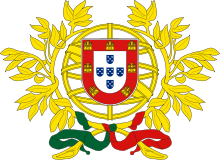Constituent Assembly of Portugal
| Constituent Assembly Assembleia Constituinte | |
|---|---|
 | |
| Type | |
| Type | |
| History | |
| Established | 2 June 1975 |
| Disbanded | 2 April 1976 |
| Succeeded by | Assembly of the Republic |
| Leadership | |
President | |
Vice Presidents |
|
| Seats | 250 |
| Elections | |
| Party-list proportional representation | |
Last election | 25 April 1975 |
| Meeting place | |
 | |
| São Bento Palace, Lisbon, Portugal | |
The Constituent Assembly (Portuguese: Assembleia Constituinte) was the Portuguese constituent assembly elected on 25 April 1975, after the Carnation Revolution (25 April 1974), for the purpose of adopting a constitution for the Third Portuguese Republic, the Constitution of 1976.
Background
After the Carnation Revolution occurred in Portugal, the National Salvation Junta dissolved all political offices previously existing in the Estado Novo (Law no. 1/74[2]). On 14 May 1974, the President of the National Salvation Junta (António de Spínola) extinguishes the National Assembly and the Corporative Chamber (Law no. 2/74[3]), the two parliamentary chambers in the Estado Novo, and establishes a transitory constitution (Law no. 3/74[3]) to be used until the new constitution being approved.
Elections
The election of the Constituent Assembly was carried out in Portugal on 25 April 1975, exactly one year after the Carnation Revolution and was the first free election in fifty years, the first in the new democratic regime created after the revolution.
The election was won by the Socialist Party, being the Democratic Party the second most voted party. The parliament had a large majority of parties defending socialist or democratic socialist ideas and the Constitution, approved on 2 April 1976, reflected such influence.
See also
References
- ↑ "Assembleia Contituinte - Cronologia" (in Portuguese). Assembly of the Republic. Retrieved 19 October 2012.
- ↑ "Diário do Governo" (PDF). Diário do Governo. 1st (in Portuguese) (97). 25 April 1974. Retrieved 19 October 2012.
- 1 2 "Diário do Governo" (PDF). Diário do Governo. 1st (in Portuguese) (112). 14 May 1974. Retrieved 19 October 2012.